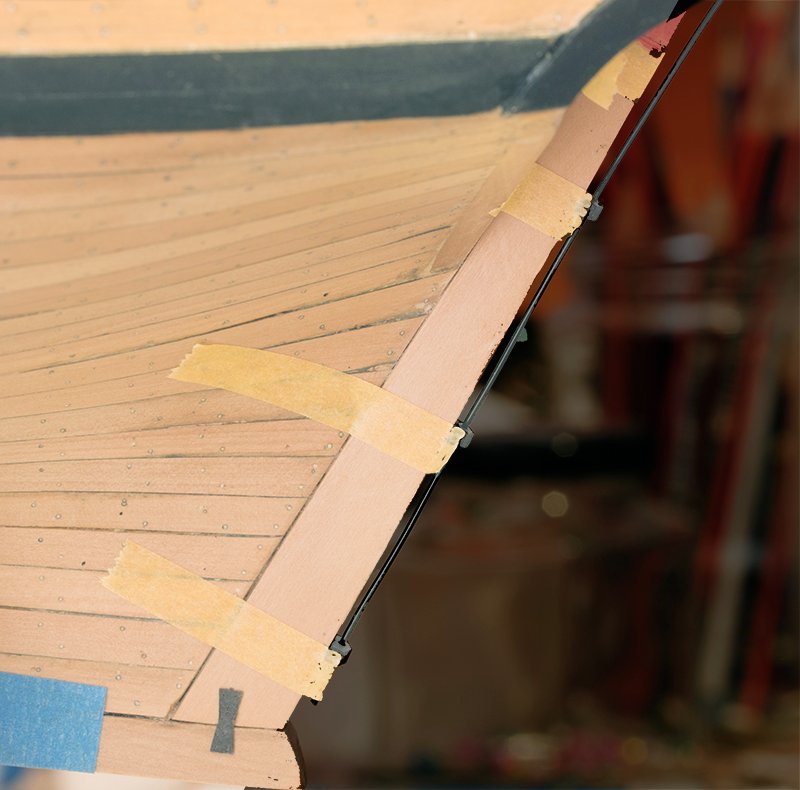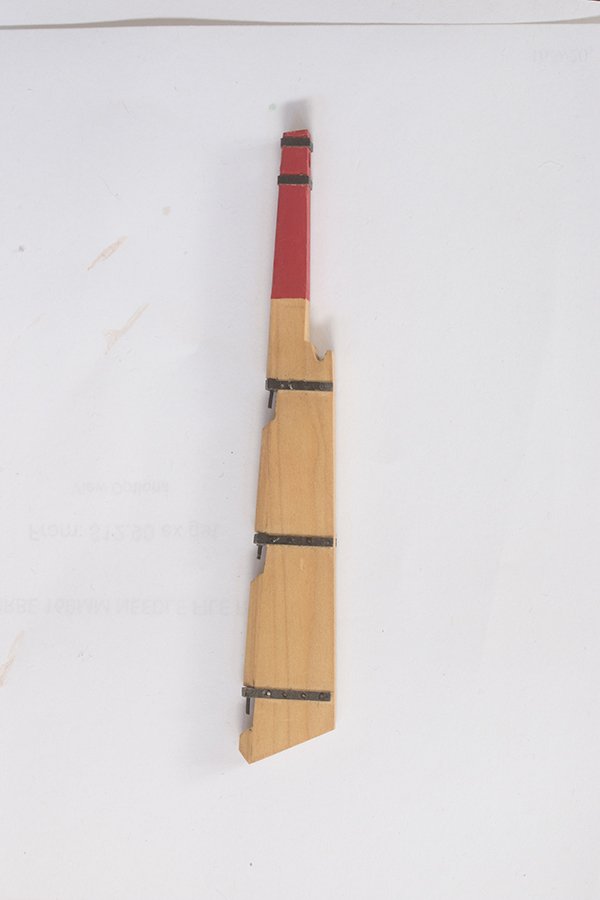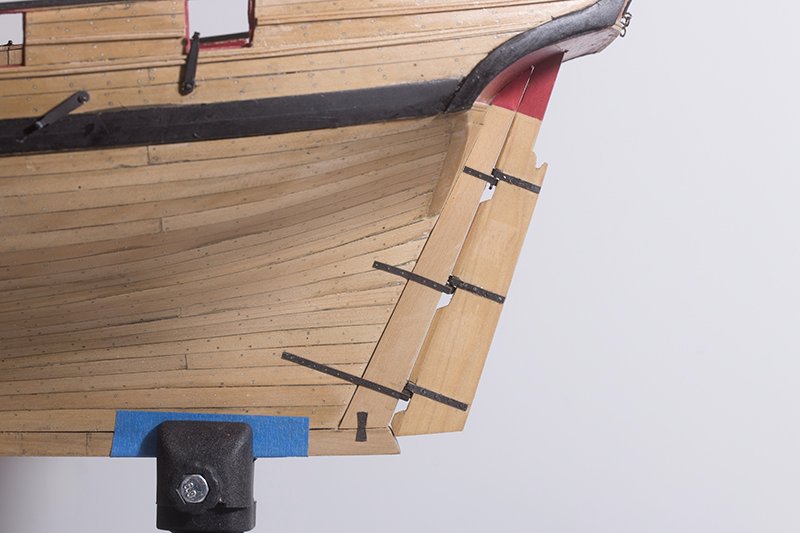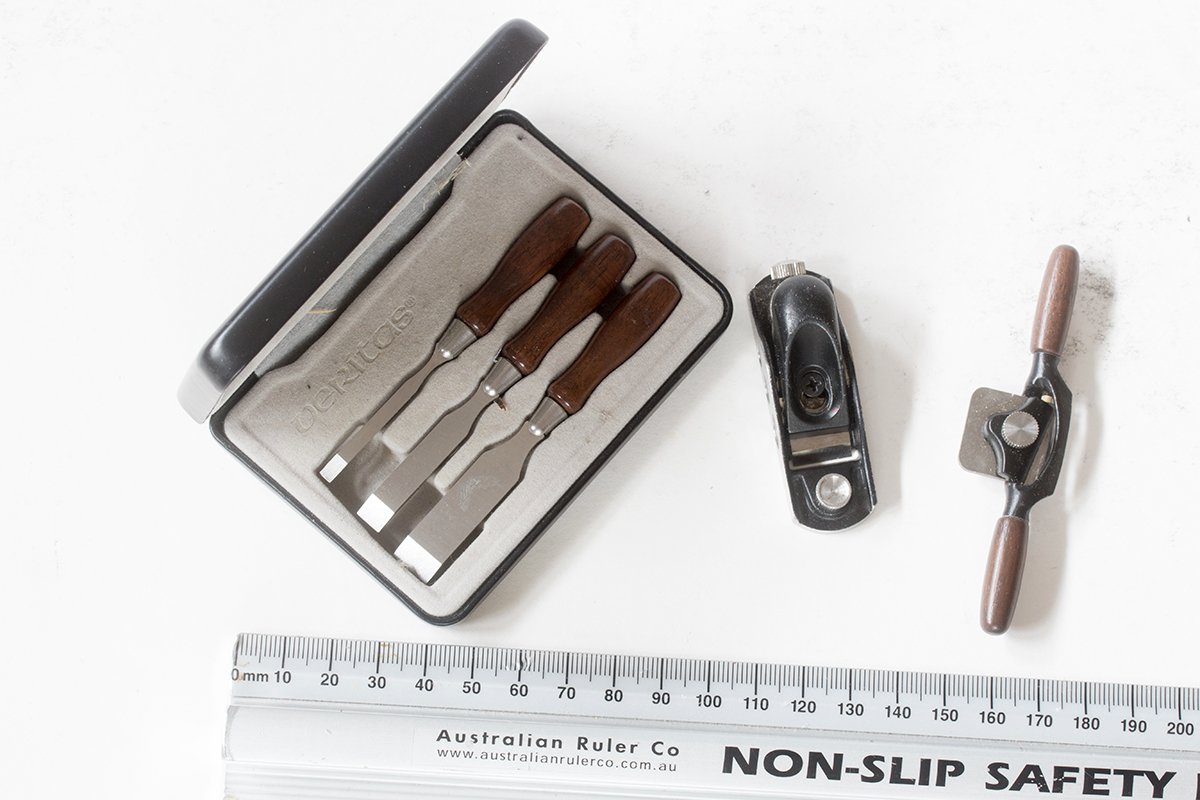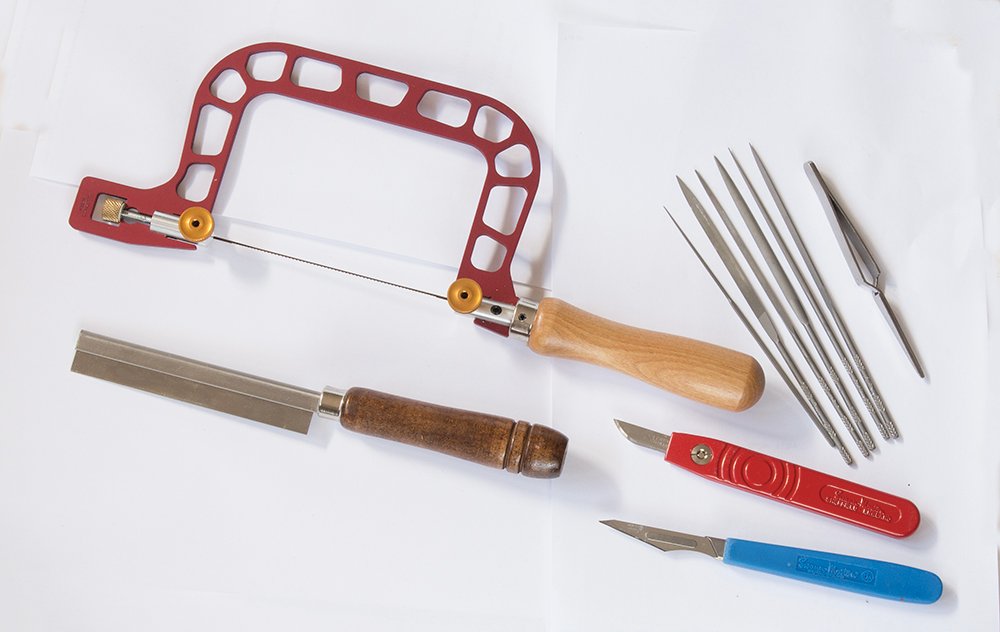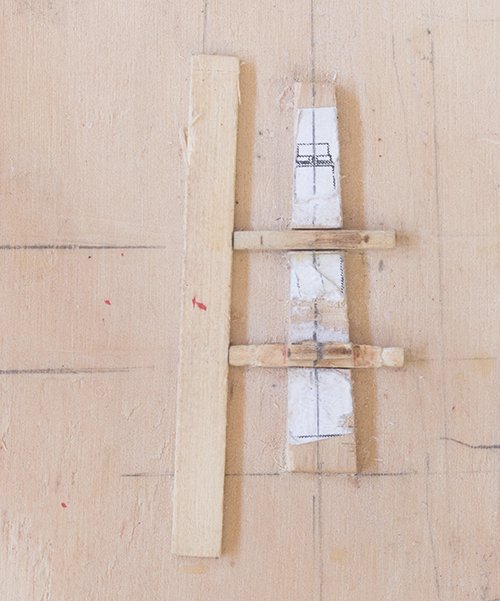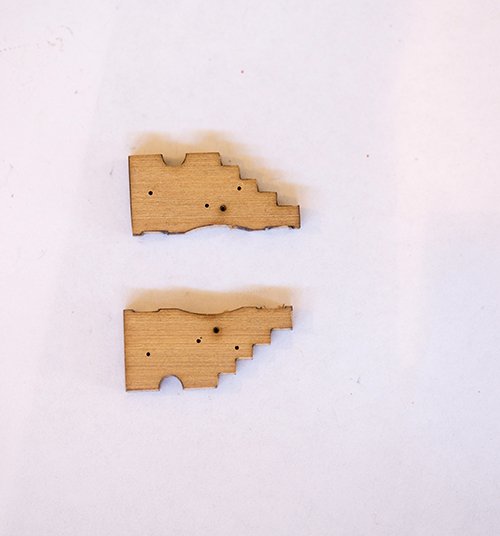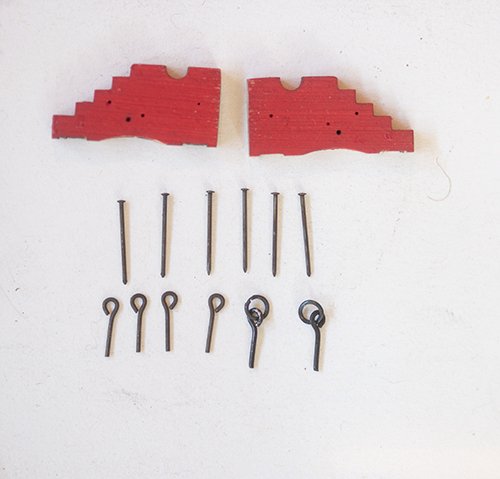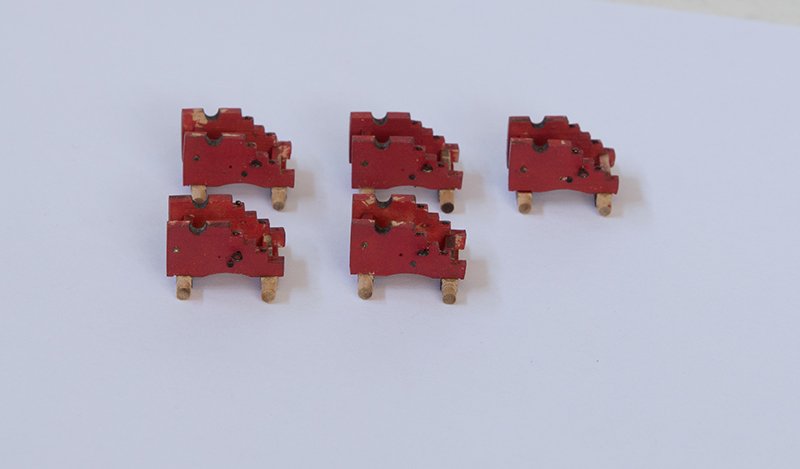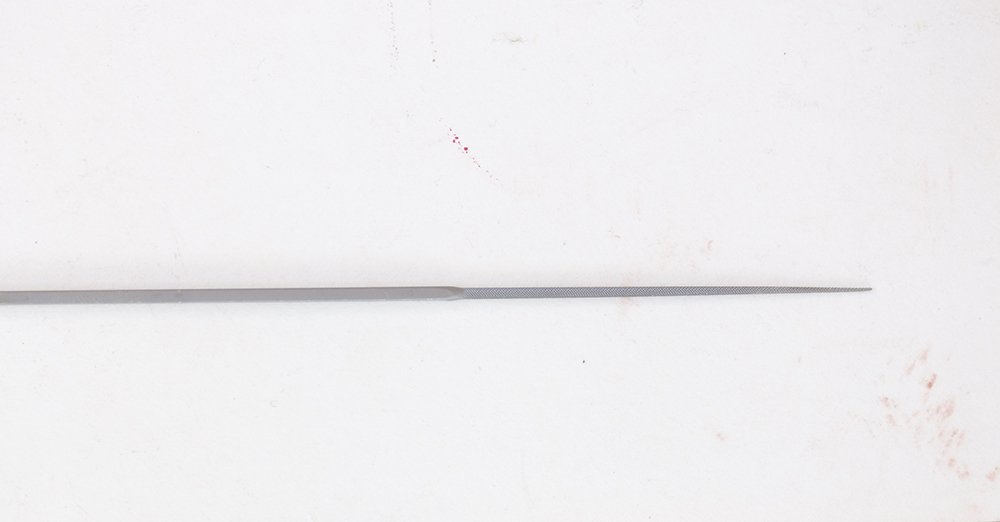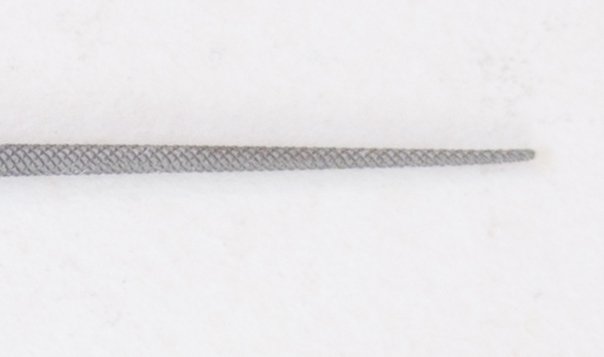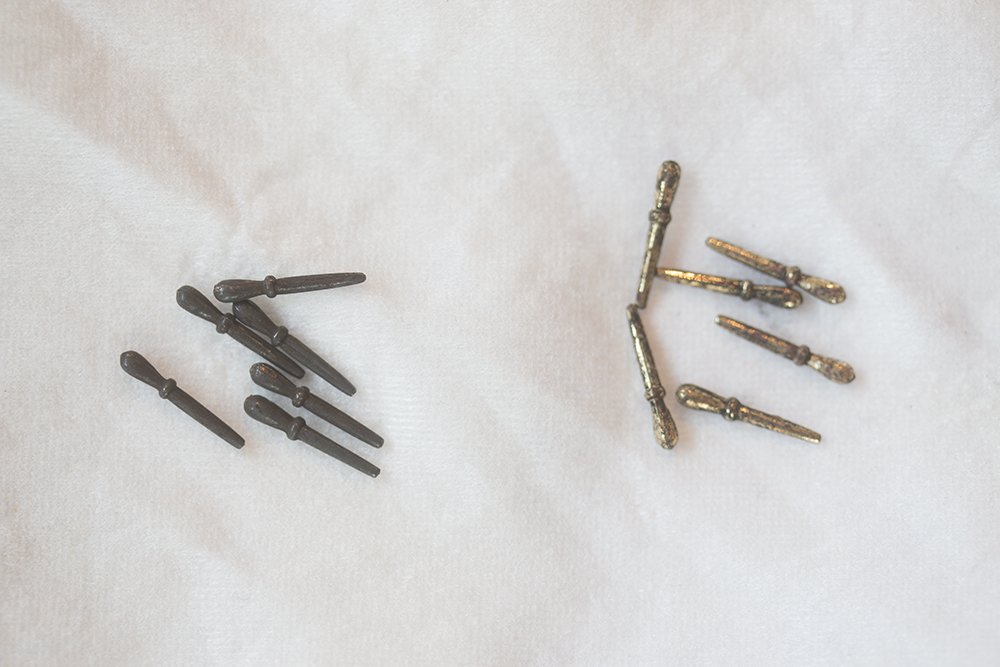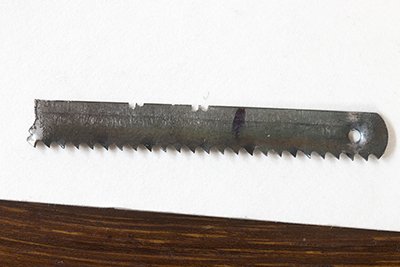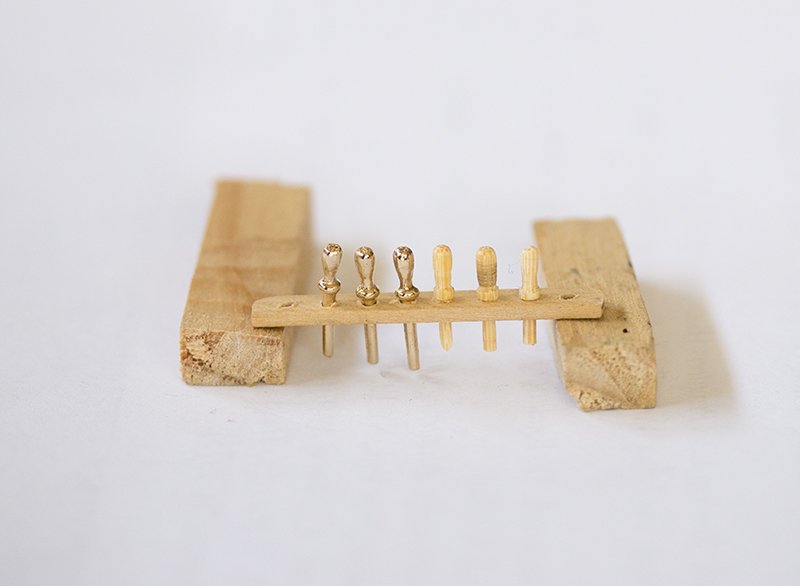
bartley
NRG Member-
Posts
424 -
Joined
-
Last visited
Content Type
Profiles
Forums
Gallery
Events
Everything posted by bartley
-
Post 35: Installation of the Rudder I shaped the rudder as described by Chuck in his post. Tapering towards the aft edge and a steep tapper on the front edge. I deviated a little from Chuck's guidelines in the installation of the Pintels and Gudgeons. Chck makes up the center piece with its two straps and then attaches it to the rudder. I found it easier to attach the center piece to the rudder in the correct position and then glue on the straps to the rudder and the center piece. I drilled the bolt holes a little deeper into the rudder and inserted short lengths of 22 gauge wire snipped of close. Again as described by Chuck I glued the the center gudgeons to the hull in a similar way and then added the strap but I used a length of wire to keep them aligned. The rudder was then hung at the red painting completed at the top. John
- 160 replies
-
- cheerful
- Syren Ship Model Company
-
(and 1 more)
Tagged with:
-
See also my post here on the chemistry of this process and its consequences on the practice of blackening John
-
This is indeed the issue - double parallel arms. The way to think about this is to consider what you do with your Jeweler's saw or coping saw. You get the best result if you move your saw vertically up and down. This is what a double parallel arm scroll saw does. It has two moving arms - one above the table and one below and the blade is mounted between them. These arms move up and down parallel to each other. The cheaper saws only have one moving arm and the blade fits into a fixed holder below the table. To understand the action of this variation think again of your jeweler's saw. The action is like rocking your saw backwards (away from you) on the upstroke and then rotating it forward on the down stroke. This is clearly not as precise and on the scroll saw tends to produce more vibration. It also produces a bit of undercut but this is not really important as you will cut outside the line and sand it back to the line. John
-
Yes, Glenn it would not be a major tool for me either as there are other ways. My saw was a Wen and cost me about A$200. For comparison a parallel arm scroll saw would cost around A$1000 out here. They seem to do a great job but hard to justify unless I was cutting my own bulkheads for example. John
- 778 replies
-
- cheerful
- Syren Ship Model Company
-
(and 1 more)
Tagged with:
-
Glenn, I will be interested to hear you you go long term with your scroll saw. I used to own one but it was a cheap model. It was OK down to about 1/8 but below that I found it pretty aggressive and difficult to control. This was partly because the lowest speed was quite fast but also because I could not buy fine enough blades to meet the three teeth rule. Maybe I should have persisted but I felt that I could do better with my jeweler's saw (see here) and so I sold it. I have since seen a demonstration at my local woodworking store of a parallel arm scroll saw. It was very smooth had a slowest speed of about 50 strokes per minute. If I bought another I would buy one of these even though they are more expensive. So I would be interested in your comments. John
- 778 replies
-
- cheerful
- Syren Ship Model Company
-
(and 1 more)
Tagged with:
-
Byrnes Tablesaw - Olha review
bartley replied to Nirvana's topic in Modeling tools and Workshop Equipment
A great review by Olha. Shows all the capabilities of the saw well. But don't copy Olha's technique for ripping! The plank should follow the billet slowly off the end of the table but if you notice in Olha's demonstration of ripping a 2mm plank, the plank disappears backwards. This is kick back, and could be dangerous. Why is it happening? Because we are ripping our planks between the fence and the blade we must impart some lateral pressure before the blade to keep the billet against the fence. Many of us do this with a block of wood. Olha uses her hands. I don't have a problem with that but toward the end of the cut she uses her other hand to guide the billet through. When you do this it is very difficult to avoid lateral pressure. There is no riving knife on this saw (which minimises the chance of kick back) but Jim has cleverly built in an offset to the fence after the blade to negate kickback. However, if you apply lateral pressure after the blade you override his engineering and close up the cut which will always cause kickback. The first thing to note about kick back is that it is fast (too fast for the camera here) and is probably 80 mph or so with this saw. Secondly, the plank may be going straight back but, in the classic case of kick back, the unsupported timber catches on a tooth on the back of the blade and rotates as it moves up the blade then flies off the top of the blade nearly upside down and, in this case, to the right because Olha is left handed. So it could be flying towards where she is standing. Being small and light it probably wont do much damage unless it hits her in the eye! So wear your safety glasses Olha. How can this situation be avoided? Use a push stick close to the blade to push the billet straight through. Don't apply any pressure aft of the blade. Otherwise its a good video Olha/ John -
A few people have asked me what power tools I use. I have to confess to living in the dark ages a bit as the only power tool I own is my Byrne's saw which I now could not live without, though I do have access to a mill via a mutual arrangement with a fellow builder. Here is part of my basic tool set:
- 160 replies
-
- cheerful
- Syren Ship Model Company
-
(and 1 more)
Tagged with:
-
Patrick, I have only just discovered this great build. Congratulations. Just to add a little to your history: The reason that the Pelican was renamed was that Drake's sponsor was Sir Chistopher Hatton whose coat of arms included a golden hind. Hatton's home was Hatton Gardens in London, now the site of the famous diamond dealer and where, in 2016, the largest robbery in British history took place. John
- 756 replies
-
- galleon
- golden hind
-
(and 2 more)
Tagged with:
-
Glenn, Veritas do make a sharpening guide especially made for their micro chisels. I also have their mini block plane and spoke shave. They are all excellent tools and have all the characteristics of their full sized tools. I use am a hand tools person . Jim's saw is the only specialised power tool I own. John
- 778 replies
-
- cheerful
- Syren Ship Model Company
-
(and 1 more)
Tagged with:
-
Post 34: Cannon Carriages A bout of arthritis has kept me away from the workshop for a while but I have now made some progress with the gun carriages. I am using Chuk's kit and a jig similar to the one he describes: I constructed a trial carriage some time ago and I found it difficult to to drill the holes for the iron work reproducibly so I decided to drill all the sides before assembly and then I thought why not install most of the ironwork before assembly as well? So here are a set of assembled carriages: John
- 160 replies
-
- cheerful
- Syren Ship Model Company
-
(and 1 more)
Tagged with:
-
Glenn, You have clearly solved the problem of fabricating a moulding cutter now but for the record, and perhaps for a later build, this is an escapement file which I used to cut my profile. This is a round one but other profiles are available. The widest part on this one is 1 .5mm and the tip is 0.4 mm - very delicate but with care, especially on brass, very narrow cuts can be made. Cheers, John
- 778 replies
-
- cheerful
- Syren Ship Model Company
-
(and 1 more)
Tagged with:
-
Indeed, all of these processes, including the use of selenium blackening, involve the oxidation of copper to copper ions (for example copper sulfate). I did outline the chemistry under the thread "blackening brass". The different effects depend on what chemical species replaces the copper be it sulfur or selenium or other metals. Modelers do not need to know the chemistry of course but there are some important practical consequences. Firstly, aged copper contains an oxide surface coating and, since it is copper which needs to be oxidized, you must remove this oxide coating before any of these processes will work efficiently. There are a variety of ways of doing this. Secondly, since copper is being removed, none of these processes should be prolonged unnecessarily . You are "etching" the surface of the copper or brass and are thus destroying fine detail. John
-
Derek, Far be it for me to provide advice to you. Your work is excellent and I have learnt a lot from your builds. However, I do know a thing or two about chemical blackening since I have a chemical background. This reaction is actually very fast so if your blackening is taking 1 minute the surface is not clean enough. On clean surfaces 10 to 20 seconds is enough. The advantage of a clean surface is that the minimum amount of selenium is deposited (no flaking) and a very uniform blackening results. Have a look at this post of mine which shows an extreme case of poor blackening Report post #35 Posted August 23 This is an example of a blackening problem which others may have experienced without knowing the reason. These belaying pins were sold as being brass so on the right I used my usual technique of treating for 5 min with sodium hydrogen sulfate then blackening. Even after about 1 min the result was poor. On reflection they were very shiny so were probably lacquered. So on the left the treatment was: - rub with steel wool, soak in acetone for about 1 min, 5 min in sodium hydrogen sulfate then blackening. After only for 10 sec the result was excellent. Incidentally, Sparex is just a very expensive packet of sodium hydrogen sulfate. So if you have access to the chemical itself it is much cheaper John
- 725 replies
-
- vanguard models
- speedy
-
(and 1 more)
Tagged with:
-
Yes indeed Kurt, boiling Sparex (which is incidentally an expensive packet of sodium hydrogen sulfate) could be dangerous because once dissolved it is sulfuric acid. It is quite dilute initially but if it becomes concentrated by boiling it will produce oxides of sulfur (chemically SO2 and SO3). These are dangerous gases and if inhaled could cause permanent respiratory damage. John
-
Others may be interested to note that the inscription reads: "Draft for building in the Marchant's Yards by contract two cutters for his Majesty’s Service to carry ten 18 pounder carronades and two 6 pounders for chase guns A copy of this draft was sent to Mr Thomas Johnstone at Dover 30 May 1806 for building two cutters named Cheerful and Surly Approved by the Lords Commissioners of the Admiralty 17 April 1806 " John
- 778 replies
-
- cheerful
- Syren Ship Model Company
-
(and 1 more)
Tagged with:
-
Dgbot, I think you might have a nomenclature problem here. I think what you mean is salicylic acid. By "Selinic acid" I think you mean selenic acid which is a more oxidized form of the selenium dioxide (or selenious acid) which we use to blacken brass. Both of these chemicals are quite toxic but salicylic acid is relatively harmless. John
-
Jim, I placed this order a week or so ago but have not heard about the postage yet: "Thanks for your on-line order #200817MM14633700 at ByrnesModelMachines.com!" I am only concerned because orders from the US can take a couple of months to get to Australia and I don't want to be caught in the Christmas rush. John
-
Jim,
I placed this order a week or so ago but have not heard about the postage yet
Thanks for your on-line order #200817MM14633700 at ByrnesModelMachines.com!
I am only concerned because orders from the US can take a couple of months to get to Australia and I don't want to be caught in the Christmas rush.
John
-
Glenn, I am always a bit reticent about providing any advice here as I am a rank beginner at this game. However, for what its worth here is a picture of my scraper and the result. I think I used the one on the left or something like it. I made about 10 of them in the end. The few tests that I did with yellow cedar gave very indistinct results and it was only when I used boxwood that I could obtain a satisfactory profile. I also stuck the strip to a glass plate on my bench with double sided tape to stop it moving. I found that several light strokes were best until the profile was established and then I could be more aggressive. John
- 778 replies
-
- cheerful
- Syren Ship Model Company
-
(and 1 more)
Tagged with:
-
Glenn, I have these scrapers. They are good but I find them far too big for the scale we are working at. I used jewelers files to cut a profile into the back of a annealed hacksaw blade. I think I might have also used a jewelers saw. There are several posts on this site about this technique. John
- 778 replies
-
- cheerful
- Syren Ship Model Company
-
(and 1 more)
Tagged with:
-
Justin, Yes, disposal is always an issue. I am a professional chemist and so disposal is part of our trade. Sparex once dissolved is essentially sulfuric acid. So to dispose of it you should pour it slowly into bicarbonate. It will fizz so do it slowly. Once the fizzing stops the Sparex is neutralized and you can dispose of it down the sink, The blackening solution is another matter. This, when fresh, is selenious acid. When you use it it is converted to black selenium metal and copper sulfate That's the blue colour. But you cant neutralise or destroy the selenium. or copper. So a spent solution contains selenium in one form or another and copper sulfate. Neither of these is too good for the environment but you only have small quantities. You shouldn't dispose of it down the sink so absorbing onto paper and burying it is probably OK. Over here we can take such things to a toxic chemicals disposal site. John
-
I actually posted this elsewhere but it is probably more appropriate here. This is an example of a blackening problem which others may have experienced without knowing the reason. These belaying pins were sold as being brass so on the right I used my usual technique of treating for 5 min with sodium hydrogen sulfate then blackening. Even after about 1 min the result was poor. On reflection they were very shiny so were probably lacquered. So on the left the treatment was: - rub with steel wool, soak in acetone for about 1 min, 5 min in sodium hydrogen sulfate then blackening. After only for 10 sec the result was excellent. Incidentally, Sparex is just a very expensive packet of sodium hydrogen sulfate. So if you have access to the chemical itself it is much cheaper John
-
The continuing saga of the belaying pins! I can make boxwood ones down to close to 1 mm in diameter at the lower end but for me consistency is the problem If I just had to make one I would be quite happy but 20 odd? I am not sure I have the patience or the skill. Here is a pic of mine versus the commercial ones:
- 160 replies
-
- cheerful
- Syren Ship Model Company
-
(and 1 more)
Tagged with:
-
Ripping Planks - what I've learned from others
bartley replied to glbarlow's topic in Modeling tools and Workshop Equipment
Glenn, It sounds like you only do ripping using the slitting blade. Of course that is what your post is about. The blade which comes with the machine is a cross-cut blade which I use quite a bit. Magic for cutting reproducible lengths. Incidentally I found that a zero clearance insert for the slitting blade improved the quality of my ripped planks enormously especial if I was cutting narrow ones, John -
Ripping Planks - what I've learned from others
bartley replied to glbarlow's topic in Modeling tools and Workshop Equipment
Glenn, Thanks for putting this together. It is reassuring to know that what I am doing is more or less the same as what you are doing. I think that a good safety tip is to "rehearse the cut". By which I mean push the wood through without the saw running. Especially if you haven't used the saw for a while or it is a cut you haven't done for a while. A couple of times I found that I had inadvertently moved the saw or stored something at the exit end that would have stopped the wood exiting freely. John
About us
Modelshipworld - Advancing Ship Modeling through Research
SSL Secured
Your security is important for us so this Website is SSL-Secured
NRG Mailing Address
Nautical Research Guild
237 South Lincoln Street
Westmont IL, 60559-1917
Model Ship World ® and the MSW logo are Registered Trademarks, and belong to the Nautical Research Guild (United States Patent and Trademark Office: No. 6,929,264 & No. 6,929,274, registered Dec. 20, 2022)
Helpful Links
About the NRG
If you enjoy building ship models that are historically accurate as well as beautiful, then The Nautical Research Guild (NRG) is just right for you.
The Guild is a non-profit educational organization whose mission is to “Advance Ship Modeling Through Research”. We provide support to our members in their efforts to raise the quality of their model ships.
The Nautical Research Guild has published our world-renowned quarterly magazine, The Nautical Research Journal, since 1955. The pages of the Journal are full of articles by accomplished ship modelers who show you how they create those exquisite details on their models, and by maritime historians who show you the correct details to build. The Journal is available in both print and digital editions. Go to the NRG web site (www.thenrg.org) to download a complimentary digital copy of the Journal. The NRG also publishes plan sets, books and compilations of back issues of the Journal and the former Ships in Scale and Model Ship Builder magazines.

